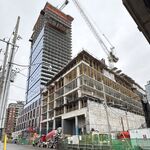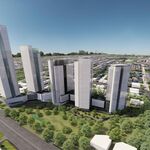crs1026
Superstar
Even a swapped line is a compromise. The Lakeshore is so much more populated. That makes it so much more challenging to do straightening. It means a lot more grade separations eventually. And all kinds of other costs and restrictions.
The past investment in grade separations is one of the reasons why I think the Kingston line is under-appreciated. More of the main roads are already grade separated. Bridging the farmers' crossings and concession roads does not imply large overpasses - many of the bridges over the TGV line are remarkably modest.
Some curves may have to be left alone, but they are already at 80-90 mph, and if they can be further banked once freight is shifted, they may not need straightening so long as we are comparing options for the HFR level speed and performance paradigm. Even accepting your premise that the line may not be adaptable to anything further, at base case we would have Kingston at 100 mph versus Havelock more frequently at 80.
The Kingston bypass route would require 50 km's or so of new line. That expense could be a rough-in of a HSR level segment. Or, it could be similar to the standard that VIA projects for the Havelock line. It would amount to 50 kms of new, plus 30 kms of rebuild Portland-Smiths Falls, versus 150kms of raw unimproved rebuild (Perth to Havelock) plus 150ish kms of simpler rebuild (West of Havelock). That differential may be closer in cost than we think. Run time to Ottawa would be equivalent with a faster run directly to Montreal. More trains run per day, I recognize, but ridership would be higher on the Montreal-Toronto leg.
(I'm still confused about HFR's best time Toronto-Ottawa-Montreal. If only one route is used, Toronto-Ottawa 3:15 + dwell in Ottawa + 1:33 Ottawa-Montreal is more than 4:45 - it approaches the current 5:04)
Let's be honest here. Presuming HFR is built on the Havelock sub, the most obvious plan going forward is progressive upgrading of that corridor to Class 7 (125 mph) and Class 8 (160 mph). Building a whole new corridor to Kingston in addition to this would be insanely expensive. A better solution would be upgrading the Brockville sub and working to do the same with the track from Smiths Falls to Ottawa to enable traffic from Kingston to access the higher speed corridor.
Are we discussing a plan to achieve HFR, and live with it until economics favour a HSR quality new build....or are we picking the future route for that new build and using it in the interim for HFR?
I can't see the Havelock route as the best candidate to achieve even Class 7. If that's what you are proposing, and if the Kingston route is not critical to the business case, then I would still argue that it must be better to put VIA on the CP line today, and force CP onto CN. (putting freight on the Havelock would be utterly uneconomic and non-operable). That would be more expensive than the base HFR plan, because CP's freight line has much higher market value than the Havelock line. But much less would be needed to upgrade the CP line to the same performance spec as VIA can buy initially on the Havelock route, with future use of the line for HSR assured. More money now, perhaps, but the net present value might be as good or better.
I'm guessing that west of Smiths Falls, the Class 7 upgrade you envision is further away than we think. Assume HFR initially does a raw rebuild Havelock to Perth, Class 6 at best. Assume that with all possible banking, VIA achieves its projected trip timing. At that point, upgrading Smiths Falls - Ottawa-Montreal from 100 mph to 125 mph is probably less money overall than upgrading the Havelock from Class 6 to anything higher. Same gain in time, likely similar ridership boost. So that project would have a better business case than improving the line west of Perth.
VIA's business case is likely the least possible cost alternative to generate a positive return. It just doesn't have much up side beyond that. I'm looking for more up side, and I think the alternatives may not prove more expensive particularly over the longer term. That may be irrelevant for the initial investors, but it's better public policy.
- Paul





